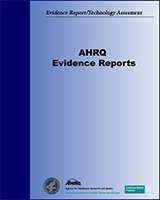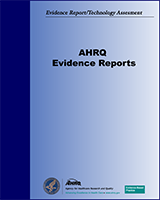Structured Abstract
Objectives:
This report summarizes the published evidence on the diagnosis and treatment of community-acquired acute bacterial rhinosinusitis in children and adults. The performance of diagnostic tests and the efficacy of antibiotics and ancillary treatments were assessed.
Search Strategy:
Human studies of sinusitis were identified from MEDLINE (1966 to May 1998), technical experts, and bibliographies.
Selection Criteria:
Acute bacterial rhinosinusitis was defined as bacterial infection of the paranasal sinuses and symptoms lasting up to 4 weeks. Only diagnostic studies that compared two or more tests were used. Only randomized controlled trials were used to assess treatment efficacy. Studies that met methodologic quality criteria were used in meta-analyses.
Data Collection and Analysis:
Data for meta-analyses were extracted in duplicate. Summary receiver operating characteristics curves were created from the meta-analyses of diagnostic tests. The random-effects model was used to estimate antibiotic efficacy. Decision and cost-effectiveness analyses were conducted to evaluate clinical management strategies.
Main Results:
Compared with sinus puncture, the reference standard for diagnosing acute bacterial rhinosinusitis, sinus radiography has moderate sensitivity (76 percent) and specificity (79 percent). Sinus ultrasonography has similar test characteristics, but the results are more variable and the procedure is not commonly used in the United States. Limited evidence suggests that diagnoses based on clinical criteria may be as accurate as those using sinus radiography. In a meta-analysis of six placebo controlled trials, antibiotics reduced the incidence of clinical failures by one-half (risk ratio [RR], 0.54; 95 percent confidence interval [CI], 0.37 to 0.79), although about two-thirds of the patients improved by 14 days without antibiotics. The risk of clinical failure did not differ significantly between amoxicillin (14 trials, RR, 0.85; 95 percent CI, 0.62 to 1.17) or folate inhibitors (e.g., trimethoprim/sulfamethoxazole) (nine trials, RR, 1.01; 95 percent CI, 0.52 to 1.97) and newer, more expensive antibiotics. No serious complications from lack of treatment were reported.
Some of the 10 trials assessing nonantibiotic, ancillary treatments reported statistically significant results. However, these trials included different treatments, often in conjunction with antibiotics, so further analyses were limited.
To minimize symptom duration, initial symptomatic treatment is the most cost-effective strategy up to a prevalence of 25 percent, the use of clinical criteria to guide treatment is most cost-effective for a prevalence between 25 percent and 83 percent, and empirical antibiotic treatment with amoxicillin or a folate inhibitor is cost effective only above the prevalence of 83 percent. Sinus radiography-guided treatment, as an initial management strategy for uncomplicated patients, is not cost effective at any prevalence.
The quality of the diagnostic and treatment trials reviewed was suboptimal. However, the results were generally consistent, sensitivity analyses showed the results to be robust, and the conclusions are consistent with the majority of expert opinions.
Conclusions:
In primary care, where the prevalence of bacterial infection in patients presenting with symptoms suggesting acute rhinosinusitis is low to moderate, initial symptomatic treatment or the use of clinical criteria to guide treatment is the most cost effective approach for patients with uncomplicated infections. If antibiotics are given, amoxicillin or a folate inhibitor should be considered initially, as should the severity of the symptoms.
Future studies should use more rigorous diagnostic standards and clinical outcome measures. The optimal duration of antibiotic treatment, the role of patient preferences in clinical decisionmaking, and the issue of emerging antibiotic resistance also need to be addressed.
Contents
Prepared for: Agency for Health Care Policy and Research, U.S. Department of Health and Human Services.1 Contract No. 290-97-0019. Prepared by: New England Medical Center, Boston, MA.
Suggested citation:
Lau J, Zucker D, Engels EA, Balk E, et al. Diagnosis and treatment of acute bacterial rhinosinusitis. Evidence Report/Technology Assessment No. 9 (Contract 290-97-0019 to the New England Medical Center). Rockville, MD: Agency for Health Care Policy and Research. March 1999.
The authors of this report are responsible for its content. Statements in the report should not be construed as endorsement by the Agency for Health Care Policy and Research or the U.S. Department of Health and Human Services of a particular drug, device, test, treatment, or other clinical service.
- 1
2101 East Jefferson Street, Rockville, MD 20852. www
.ahcpr.gov

